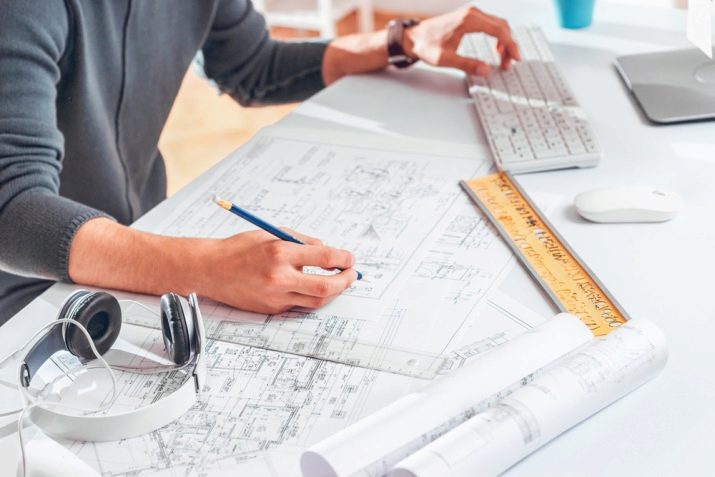One of the most important and crucial moments in the life of every person is the choice of a profession. At the same time, in the process of determining the future career path, it is necessary to take into account a huge variety of factors: personal interests and inclinations, abilities and skills, the demand for the profession, the possible level of material remuneration for work, and much more.
If you are prone to technical subjects (for example, mathematics, physics, drawing), then you should pay attention to the position of design engineer. Today in our article we will take a closer look at the characteristics of this profession.
Who is that?
Design engineer - This is a professional who is engaged in the development of buildings and structures, he calculates the load that will fall on all the key elements of the object: foundation, frame, beams, columns, suspended lifting equipment.
This specialist can be involved in various areas of human life: he deals with civil, industrial, warehouse, commercial and other structures. Moreover, objects can be made of a variety of materials: iron, concrete, metal, wood, stone. The specialty of the design engineer is very complex and responsible. The job of creating and filling out the drawings, as well as the corresponding project documentation, rests with the professional.
Description and characteristic of work design engineer, which is necessary for a particular object, is prescribed in detail in the technical task.This document, among other things, contains the technical characteristics of the construction site. The specialist must conduct a qualified assessment of the assignment, determine the possible timing of its implementation.
In the course of his professional career, design engineer performs a number of tasks including consultations with the customer, creation of a design drawing, implementation of control functions, and much more. If we talk about the nature of the work of a specialist, then most often he acts as an employee and works at the enterprise 8 hours 5 days a week.

Pros and cons of the profession
As mentioned above, a design engineer is a very responsible position, which requires an extensive theoretical and practical training from the person occupying it. Accordingly, you need to make sure 100% in advance that you want to engage in such professional activities. In order to make an objective and balanced decision, you need to carefully analyze and evaluate the existing advantages and disadvantages of a specialist.
First, let's talk about the pros.
- Demand. Design engineers are highly qualified professionals who constantly remain relevant in the labor market. Even today you can find a large number of open vacancies in the specialty. Thus, having received the appropriate diploma, you can be sure that you will not be left without a workplace. On the contrary, employers compete for competent professionals, so you will have a choice.
- Direct result of labor. Unlike many other professions, the work of a design engineer has an end result. That is, you can actually see the result of your work. This characteristic is rare and is valued by many people psychologically.
- Creativity and creativity. In the course of carrying out his professional tasks, the design engineer meets not only with typical responsibilities, but also very often can show his individual creative and creative abilities. Thus, your work can become a kind of outlet.
- High level of remuneration. If we compare the salary of a design engineer with the average salary in the country, we can conclude that it is in the category above average. Thanks to a decent material reward for work, a person can maintain a high standard of living, as well as provide for his loved ones.

However, in addition to the pros, attention should be paid to the minuses.
- Responsibility. The profession of design engineer is associated with a high degree of responsibility. The work of a specialist directly affects the lives and health of people, so he should be as attentive and serious as possible.
- High stress level. Due to the presence of the above-described high level of responsibility, the specialist is in constant emotional stress and stress, which can negatively affect the mental and psychological health of a person.
- A long and complicated learning process. In order to be able to obtain the position of design engineer, you must have the appropriate education. Moreover, the learning process itself is very complex, because a young person will have to master a large number of technically complex subjects. In addition, increased attention is paid to the acquisition of practical skills. Accordingly, the applicant needs to be prepared for high loads.
As you can see, the advantages of a profession outweigh its disadvantages. However, for some people, the existing disadvantages are so important that they completely abandon this career path. One way or another, but the choice is yours.

Responsibilities
The engineer-instructor does his daily work strictly in accordance with official documents, namely job description, professional standard and internal documents of the company. All these documents should be carefully examined before accepting an official invitation to find a job. Remember that for failure to fulfill or for poor performance of your professional duties, you may be liable (from dismissal from office and disciplinary reprimand to criminal prosecution).
In general, the standard working functions of a design engineer include:
- collecting customer orders, clarifying the necessary parameters (terrain, technical and structural features, desired external design and much more);
- creating a concept and making initial calculations;
- coordination of their ideas with the customer;
- development of sketches and drawings;
- consultations with designers, marketers and other specialists;
- creation of computer graphic models of objects;
- conducting preliminary tests (for example, checking structures for strength and ergonomics);
- identification and immediate elimination of existing shortcomings and shortcomings;
- presentation of the final project to management and customers;
- the implementation of its activities strictly in accordance with a predetermined technical task;
- development, preparation and completion of complex project documentation;
- exercise of control and oversight functions for downstream employees.

At the same time, it should be borne in mind that a more accurate list of work responsibilities will be determined by the employer in accordance with what kind of professional rank an engineer has.
For example, an employee with an initial category can perform only the simplest tasks, he is forbidden to make independent decisions. but with increasing discharge, the area of responsibility also increases. So, for example, a specialist of the 1st category can occupy leadership positions.
It should be borne in mind that this The list of duties of a specialist is not closed. Despite the fact that it is regulated by the documents described above, each employer can change and supplement this list depending on his personal requirements, the specifics of the work of a particular enterprise and some other factors. Thus, you should always be ready to adapt and adapt to changing conditions.

Requirements
In order for a specialist to fully, competently and effectively carry out his professional functions, It must meet a number of requirements. Moreover, in addition to the working requirements that are regulated by the professional standard, there are requirements regarding personal characteristics. Only if your character combines all the necessary qualities, you can become a successful specialist, relevant in the labor market and in demand among employers.
Professional
Among the mandatory professional competencies of the design engineer can be identified:
- use of a personal computer at the level of an experienced user;
- knowledge of specialized engineering programs - MS Word, Exel, AutoCad, Archi Cad, SCAD, ING +, Lira, REVIT;
- knowledge of foreign languages (at least English, an additional foreign language will be an advantage);
- knowledge of regulatory documents, laws and regulations that regulate the activities of a specialist;
- understanding of the latest professional trends;
- thorough knowledge of safety rules and regulations.

Personal
In addition to professional qualities, many employers pay attention to the personality traits of the applicant for the position of design engineer, because the specialist must fit in well with the existing team and become an integral part of it. Among the important personal characteristics are usually distinguished:
- responsibility;
- analytical thinking;
- ability to make independent decisions;
- stress resistance and emotional stability;
- leadership skills;
- teamwork skills;
- sociability;
- attentiveness to small details;
- perseverance;
- creativity and creativity;
- the desire to develop and improve;
- focus on achieving the goal;
- activity and initiative;
- ability to argue.
The above skills, abilities and qualities can be called standard. A person who wants to move up the career ladder and develop in the chosen professional field must know and be able to do much more. The presence of additional competencies favorably sets you apart from other job seekers and enhances in the eyes of a potential employer.

Education
In order to take the position of design engineer, you need to get the appropriate professional education. At the same time, for starters, you can graduate from a technical school or college (after the 9th grade of the school) and only then go to the university (if you wish, you can go to college immediately after the 11th grade). One way or another, it is worth remembering that traditionally employers give preference to specialists with higher education.
When choosing a particular institution, focus on those institutions that are located in large cities of Russia or in the capital of our country. Such training organizations are respected and respected among the professional community. Before entering a university, you need to visit the admissions office and find out what subjects you need to take in exams for admission.
Approach the training process as carefully and responsibly as possible. Try to get only the highest scores, as many employers, in addition to the diploma itself, require candidates for the post also extract from the diploma. In addition to theoretical training, pay attention to obtaining the necessary practical skills.
Depending on the training program you have chosen, as well as on the level of training, the educational process can last from 3 to 6 years (and even more). Moreover, if you want to move up the career ladder, then you should not stop at getting a basic education. Continually upgrade your skills and strive to be assigned a higher category.

How much does it make?
The average salary of a specialist is at the level of 50,000 rubles. However, experienced and competent professionals can get 3 times more. As a rule, but the following factors influence how much a specialist receives:
- the level of education;
- experience;
- region of residence;
- field of activity;
- sector (private or public).
Where to work?
A design engineer can work in various fields of human activity:
- engineering;
- aircraft construction;
- the field of aviation and aircraft engine design;
- furniture manufacturing enterprises;
- car manufacturing organizations;
- branch of robotics;
- scope of metalwork;
- design organizations;
- ateliers and clothing workshops;
- sphere of drilling rigs.

Thus, the corresponding education of a design engineer opens the door for you in a variety of areas. First of all, focus on your interests and inclinations.
Prospects and career ladder
After graduation, a young man will be able to become an assistant design engineer or novice specialist. Over time and after gaining the necessary experience, he can apply for a higher position - for example, chief or lead specialist. In addition, the design engineer has the opportunity open your own design bureau and become a businessman.











